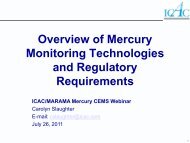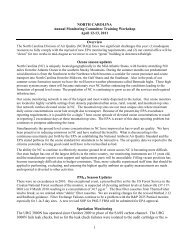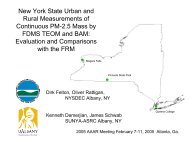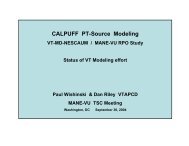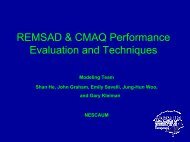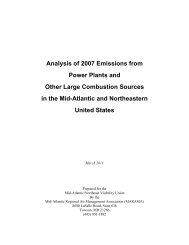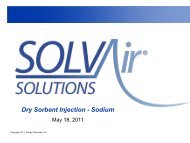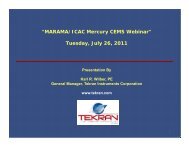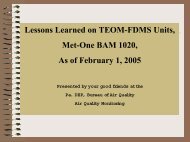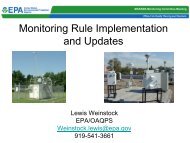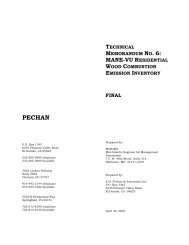Importance of Protocol Gas Accuracy for Emissions ... - MARAMA
Importance of Protocol Gas Accuracy for Emissions ... - MARAMA
Importance of Protocol Gas Accuracy for Emissions ... - MARAMA
Create successful ePaper yourself
Turn your PDF publications into a flip-book with our unique Google optimized e-Paper software.
PGVP• <strong>Protocol</strong> <strong>Gas</strong>es from an historic perspective• Historical Audit• The PGVP
<strong>Protocol</strong> <strong>Gas</strong>es From an HistoricPerspectiveGENESISINthe beginningthe Lord created
<strong>Protocol</strong> <strong>Gas</strong>es From an HistoricPerspective• Calibration <strong>of</strong> CEMS to NIST traceablestandards– Only “traceable” standards available wereSRMs– SRMs only available in limited quantities andor concentrations also “small cylinder (800 l)”– EPA and NIST developed EPA Traceability<strong>Protocol</strong> For Assay And Certification Of<strong>Gas</strong>eous Calibration Standards
<strong>Protocol</strong> <strong>Gas</strong>es From an HistoricPerspectiveThe Green Book
<strong>Protocol</strong> <strong>Gas</strong>es From an HistoricPerspective
<strong>Protocol</strong> <strong>Gas</strong>es From an HistoricPerspective• Primary Standard• SRM– Standard Reference Material• NTRM– NIST Traceable Reference Material• GMIS– <strong>Gas</strong> Manufacturer’s Internal Standard
Primary Standard• Produced by NIST using gravimetricprocedures• Analyzed via two or more independentmethods over time to confirmconcentration• Maintained at NIST (Gaithersburg, MD)
Standard Reference Material• Produced under contract to NIST by aspecialty gas company (currently only twocompanies manufacture <strong>for</strong> NIST)• NIST analyzes each cylinder over time toconfirm concentration. Analysis is directlytraceable to PRM.• Sold by NIST
NIST Traceable Reference Material• Produced by a Specialty <strong>Gas</strong> Manufacturer in abatch; <strong>for</strong> cylinder to cylinder homogeneity(currently 4 companies produce NTRMs)• Cylinders are analyzed over time• Data is reported to NIST• NIST requests at least 10% <strong>of</strong> the batch be sentto NIST and NIST per<strong>for</strong>ms its own analysis• NIST “names” the batch• NTRMs can have less uncertainty than SRMs
NIST Traceable Reference Material
<strong>Gas</strong> Manufacturer’s Internal Standard• Produced by a Specialty <strong>Gas</strong> Manufacturerfollowing the “Green Book”• Cylinders are analyzed over time vs. SRMor NTRM following the “Green Book”• Cylinder is named by manufacturer
<strong>Protocol</strong> <strong>Gas</strong>es From an Historic• RGM – Research <strong>Gas</strong> Material– NIST named cylinder <strong>for</strong> which there is notthe demand and/or the “politics” to have anSRM.• NTRM PrimePerspective– Similar to NTRMs except NIST analyzes andnames each cylinder. Driven by the autoindustry to minimize uncertainty <strong>of</strong> tail pipeemissions data
<strong>Protocol</strong> <strong>Gas</strong>• Manufactured and analyzed following thegreen book.– Single analysis <strong>for</strong> “non-reactives”– Dual analysis one week apart <strong>for</strong> “reactives”• Analyzed against– SRM– NTRM / NTRM Prime / RGM– GMIS
Minimum Requirements <strong>for</strong> U.S. EPA <strong>Protocol</strong> <strong>Gas</strong>esThe following is the minimum in<strong>for</strong>mation to be included whenreviewing the certification documentation <strong>for</strong> U.S. EPA <strong>Protocol</strong> gases.• 1. Cylinder identification number (serial number).• 2. Certified concentration within three digits <strong>of</strong> the standard (ppm or % -mole basis).• 3. Balance gas in the standard mixture.• 4. Cylinder pressure at time <strong>of</strong> certification.• 5. Assay/Certification date.• 6. Certification expiration date.• 7. Reference standard identification (standard type [SRM, PRM, NTRM, or GMIS],cylinder number and concentration).• 8. Statement that the assay/certification con<strong>for</strong>ms to EPA protocol guidelines.• 9. Analytical method used.• 10. Laboratory identification number (laboratory name, laboratory address).• 11. Chronology <strong>of</strong> previous EPA protocol gas certification <strong>for</strong> this cylinder.• 12. Analytical accuracy <strong>of</strong> the mixture.• 13. Statement that certification was corrected <strong>for</strong> interference's (if applicable).• 14. Ensure the concentration certified by the vendor matches the cylinder label value.
Audit History <strong>of</strong> <strong>Protocol</strong>s• 1970’s -1996 EPA audited gases• Posted results– In 1995, one vendor <strong>of</strong>f by -16.3% (CEM wouldunderreport)• Strong utility and vendor support• Auditing strongly correlated with improved gasquality• Audit discontinued after 1996 due to budgetaryconstraints• Audit reinitiated in 2003
200320022001302520151050Audit Results199419951996199719981999200019931992% Failures
2003 <strong>Gas</strong> Audit• First audit in 7 years• Blind audit• 14 national gas vendors• Similar procedures as in past• SRMs and NTRMs used• 42 <strong>Protocol</strong> tri-blend cylinders
Results• Overall failure rate: 14 <strong>of</strong> 126 analyses (11%)• 57% <strong>of</strong> vendors failed• SO 2 : Worst tag value ~2.5% high• NO: Worst tag value ~8% low• CO 2 : Worst tag value ~4.9% high• All 42 cylinders met the <strong>Protocol</strong> Proceduredocumentation requirements
200320022001302520151050Audit Results199419951996199719981999200019931992% Failures
EPA wants to improve andmaintain the quality <strong>of</strong> USEPA <strong>Protocol</strong> gases thusPGVP
Part 58 (ambient)1/17/06<strong>Gas</strong>eous pollutant concentration standards(permeation devices or cylinders <strong>of</strong> compressedgas) used to obtain test concentrations <strong>for</strong> CO, SO 2,NO, and NO 2must be traceable to either a NationalInstitute <strong>of</strong> Standards and Technology (NIST)Traceable Reference Material (NTRM) or a NISTcertified<strong>Gas</strong> Manufacturer's Internal Standard(GMIS), certified in accordance with one <strong>of</strong> theprocedures given in reference 4 <strong>of</strong> this appendix.Vendors advertising certification with theprocedures provided in reference 4 <strong>of</strong> thisappendix and distributing gasses as “EPA<strong>Protocol</strong> <strong>Gas</strong>” must participate in the EPA<strong>Protocol</strong> <strong>Gas</strong> Verification Program or not use“EPA” in any <strong>for</strong>m <strong>of</strong> advertising.
Part 72 & 75 (stack)1/24/08
EPA PGVPContractor
Thank you !Questions ?



